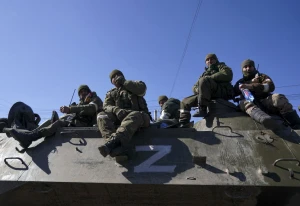
NATO's response to Oreshnik, new U.S. artillery, frontline update. Serhiy Zgurets’ column
The Supreme Allied Commander Transformation, Admiral Pierre Vandier, spoke to Defence News about how the Alliance should counter the threat of Russia's Oreshnik missile
NATO on ‘Iron Dome’ for Europe
Previously, the Alliance avoided such assessments, as they pertain to NATO's capabilities in countering Russia.
So, what is the Alliance saying now, considering the experience of Russia's war against Ukraine and the stories surrounding Oreshnik, which Putin has resurrected from the remnants of Soviet developments and is now using to scare Europe, claiming that NATO has nothing to counter this missile?
Pierre Vandier stated that the idea of building a powerful missile defense system in Europe to protect against Russian ballistic missiles is futile. No hypothetical "European Iron Dome" can protect or prevent Russian aggression. What is needed instead is similar long-range strike capabilities. If Russia has the means to strike Europe at a depth of 2,000 km, NATO must also have the ability to respond, the admiral said. Russia must consider the consequences of their actions before carrying them out.
It sounds promising, but what about NATO countries' deterrence capabilities in this context?
There are some nuances here. Germany, for instance, plans to resume production of TAURUS missiles only next year, while the UK and France are updating their SCALP and Storm Shadow missile procurement programs for their armed forces. This year, leading European nations launched a project called the European Long Strike Approach to develop long-range missiles. However, as the NATO admiral admits, this progress is rather slow. He held meetings with Franco-German industrial leaders and European defense industry executives, telling them they resemble herbivorous dinosaurs that assume there’s enough grass to sustain them.
Likely, these statements will lead to concrete steps to strengthen long-range weapons production within NATO countries. Yet, all such initiatives must proceed alongside ongoing support for Ukraine, which currently serves as the shield containing Russian aggression. Meanwhile, most European nations, along with their armies and defense industries, remain, in the high-ranking NATO representative's assessment, herbivorous structures.
New U.S. artillery systems
The United States is addressing the development of a gun capable of destroying drones and cruise missiles, drawing on challenges from the Ukraine-Russia war. In this conflict, air defense systems are in short supply, while threats from drones and missiles are increasing. The U.S. Department of Defense plans to sign a contract with BAE Systems, a leading American international company, to produce a system that will target drones and cruise missiles.
This artillery system will build on previous developments. The U.S. has already created hypersonic projectiles, known as railguns, which use electromagnetic accelerators on ships to launch hypersonic rounds. These systems will now be adapted for standard artillery guns.
By 2027, the U.S. Army hopes to receive the first prototype, with testing set to begin in 2028. The initial version of the gun will likely be based on the Swedish Archer self-propelled artillery system, known for its automation, or an entirely new design may emerge. Does hitting a drone or cruise missile with artillery seem far-fetched? Not at all - tests conducted in 2022 used an M109 Paladin howitzer and a new projectile to successfully intercept a cruise missile during firing.
Currently, BAE Systems is working to update and modernize these systems. Ukraine should also explore its own solutions for effectively countering Russian drones, employing mobile groups and other tactics. At some point, these American innovations could prove valuable on our battlefield.
Frontline update: Kharkiv sector
In the Kharkiv sector, the 13th Operational Brigade of the National Guard, known as Khartia, holds the line. This unit, part of Ukraine's Defense Forces, evolved from a volunteer territorial defense group into a combat-ready brigade. Khartia fighters were among the first to reach the Russian border during the counteroffensive in September 2022 and played a key role in repelling a renewed Russian assault on Kharkiv. This month, in their honor, Ukrposhta released a set of stamps dedicated to the brigade. Currently, the guardsmen continue to defend the Kharkiv region along the Kupyansk-Lyman axis.
Volodymyr Dehtyarov, a representative of the public relations service for the National Guard's 13th Operational Brigade Khartia, described the current frontline situation. According to him, Russians have been employing infiltration tactics over the past two weeks, advancing in small groups of two to three soldiers on foot. Anything within reach of Ukrainian FPV drones or remotely mined roads is promptly neutralized. As a result, Russian troops move in small groups, primarily during daylight hours, as they lack night vision equipment. Their strategy relies on one or two out of 10–11 soldiers reaching the next tree line, where they attempt to gather enough personnel for an attack. Following a successful operation by Ukrainian forces to retake a tree line several weeks ago, Russian forces have been attempting to reclaim this area without success. Most of their efforts are thwarted by strike drones, artillery, and mortars, rarely escalating to small arms engagements. This approach is vital because the value of each infantryman's life far outweighs that of a dozen Russian soldiers.
In early December, the brigade conducted its first fully robotic operation against Russian forces in Kharkiv direction.
“This operation was meticulously planned and involved dozens of robotic systems: a ground drone equipped with a machine gun, kamikaze drones, mining and demining drones, reconnaissance drones, and FPV drones. The uniqueness of the operation lay in the coordinated use of various aerial and ground systems to achieve a combined effect. The operation is still ongoing, so we cannot disclose all tactical details or its exact objective. The complexity stemmed from the need to coordinate the actions of dozens of crews positioned along the frontline. It was crucial to ensure that the communication frequencies of different systems didn’t interfere with each other and operated in unison. We succeeded,” explained Dehtyarov.
The brigade began by creating a dedicated unit - a platoon of robotic ground systems. However, UAVs are no longer concentrated in a single company. Each platoon and battalion must now have separate UAV units, both strike and reconnaissance. Logistics units should also utilize aerial drones, for instance, for remote logistics and delivering supplies to the front line, saving time and resources, the serviceman explained.
"Logistics units can use ground drones to deliver ammunition and mines to vanguard positions. Unmanned systems, whether ground-based or aerial, will inevitably be employed across various units. Reconnaissance, anti-tank missile systems, and artillery all require adjustment or deployment of drones. The role of a drone operator will become an integral part of every military specialty. We provide rapid feedback, and manufacturers promptly carry out repairs and upgrades. Drones evolve quickly, and within a month, you might not recognize the workshop of the National Guard brigade. It is crucial to have personnel with technical education - engineers who can design and improve models. Some of our in-house developments are the result of the creativity and engineering approach of our specialists," he added.
Regarding training and internal culture, the military remains open and willing to share their methods. They continuously exchange experiences with other brigades of the Armed Forces, the National Guard, and other Defense Forces units. Their work is guided by NATO planning standards, personnel training, and respect for human dignity and life. The brigade has its own training center, where experienced instructors train new recruits.
In terms of recruitment, they actively collaborate with external advertising agencies to attract new members. A hotline (3333) is available, along with job postings on platforms like Work.ua and others. The brigade offers a wide range of professions and specialties, ensuring a role for everyone based on their civilian expertise, Dehtyarov explained.
- News












































